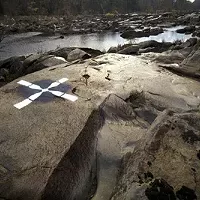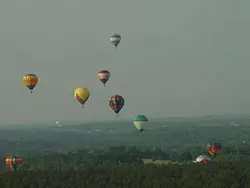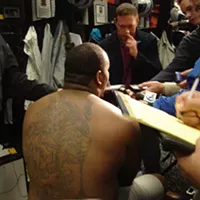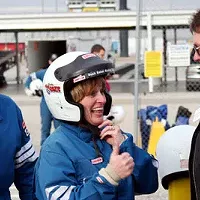Gliding through the sky with the wind at your back is like riding an escalator that never ends, says competitive hot air ballooning pilot and Statesville resident Sam Parks. A former national runner-up, Parks fell in love with the impractical aeronautical device while "chasing" for another competitor 20 years ago in Statesville's annual ballooning festival. A chaser has the less than glorious job of following the balloon in a van so they aren't forced to hitchhike once they land. In exchange for his services, the ballooner usually gives the chaser a ride. Parks was hooked right away.
Because air is hotter and unstable in the day, flying can only happen in the couple of hours after sunrise and before sunset. A wind greater than 10 mph is considered too dangerous to fly, and ballooning in the rain is out of the question. (My scheduled ride was washed out. And, at the big festival in Statesville a couple of weekends ago, wind grounded the balloons until Sunday when only six of 50 ballooners got off the ground.)
Crash landings are caused by dangerous weather or burner failure. If you are worried that something could puncture the balloon and cause it to crash, it would have to create a hole larger than the carriage to sink it. As far as a collision with a bird, "not unless it's blind," says Parks. "It's not dangerous like NASCAR dangerous."
Races are called tasks and they aren't contests of speed. One of the races that would have taken place in Statesville is called a "Hare and Hound Task." Once the hare balloon takes off, the other ballooners in the competition are allowed to inflate. The goal is to mimic the flight path of the trailblazer, which is a challenge because the pack starts about 10 minutes after the hare.
The other common task in competitive ballooning is called a Fly In. The Balloonmeister gives price coordinates marked by an X on the ground, and competitors must go out three miles to a spot that they think will blow them to it. They use helium balloons to test wind currents to help gauge a starting point. Both challenges end with competitors throwing a beanbag at an X.
Parks, an eight-time state champion, qualified for the bi-annual World Championships in 2002, because of an accurate beanbag toss in the nationals. He was only 50 points from first, which is the difference of six inches on the baggie toss. On a media day a couple of weeks ago, I went up in a tethered balloon and got a chance to fling one of the beanbags, which has an aerodynamic nylon tail that helps it fly from far distances. The throwing technique, Parks showed me, is to get your arm to windmill as fast as possible before you release which, in a carriage that was a tight fit for three people, made me feel like I might throw myself out of the carriage along with the beanbag.
Getting the balloon to go at speeds and directions of the ballooners will is a matter of finding wind currents that are layered at different altitudes. Ballooners use a GPS system to help navigate and generally trust that the Coriolis effect will hold true -- that wind currents are faster and turn the balloon to the right higher up in the atmosphere. The effect is reversed on the other side of the equator. Thus, flying in Australia where the World Championships were held in 2002, presented a unique challenge to Northern hemisphere flyers.
Statesville is also home to the largest balloon manufacturer in the country, Firefly Balloons. The company makes about 60 balloons a year, 30 percent of total hot air ballooning production. Balloon prices range from $32,000 for a standard design to $150,000 for a custom-made one like a Jesus bust coming out of a cloud or an upside down Humpty Dumpty, mouth agape in pre-fall shock, legs flailing skyward.
Most people have the capacity to get a ballooning license, says Parks. "We don't have engines. We don't have rudders. We don't have ailerons. We have to go through a lot of the same training as airplane pilots do, but it's very abbreviated." Bottom line, he adds: "I can get you your license in three months."
Parks appreciates the gender equality in the sport. "One thing not common is that females can be just as proficient as males. Strength, or even age, has nothing to do with success," he says.
Another little played sport that also boasts male/female indifference is foxhunting. "You can't outmuscle a horse. You can try, but it usually doesn't get you far," says Rita Mae Brown.
Two weeks ago, I lunched with Brown, influential activist in the feminism and gay lib movements in the '60s and New York Times bestselling author. Brown was in town a couple of weeks ago touring for her fifth novel in a mystery series, The Hounds and the Fury, centered around a foxhunting club. Incidentally, Faulkner's daughter is an avid foxhunter and friend of Brown's. Brown herself is the Master of Foxhounds at her own club in Virginia where she resides. (Mecklenburg Hounds, Charlotte's local club, kicked off its season early this month.)
At the lunch, Brown showed up in traditional foxhunting garb: a riding hat, sporting jacket, yellow vest and stock tie (worn because it can be tied to hold a broken limb in place if a rider falls from their horse. It's considered wimpy to return early from a ride because of a broken appendage).
Brown is quick to clarify that foxes aren't actually killed in the United States. In Britain, the sport served a function: to reduce the sheep-feasting pest. But here, it's just about the chase. Members of a tri-species team working together to pursue a fourth species -- a nimble and crafty escape artist. Foxhounds pick up the scent of the fox and begin the chase, with humans on horseback following behind who communicate directions to the canine runners from their higher vantage point. The hardest part about training is getting the foxhounds to learn commands. Before she teaches them a single command, Brown spends a whole year reading poetry so the hounds can get used to her voice.
Brown describes the sights and smells of hunting -- the skunk-like fox pheromones (once humans can smell them, they've risen too far out of the hound's purview), the sweeter than human scent of horse sweat, the post dawn landscape -- as the most addicting part of the sport.
Speaking of 5.00000
-
A Family Affair
Dec 12, 2007 -

What If the Water Runs Out?
Dec 12, 2007 -
Body Talk
Dec 12, 2007 - More »
Latest in Urban Explorer
More by Jared Neumark
-

Best of The Blotter 2007
Nov 28, 2007 -

Preaching and drinking
Mar 7, 2007 -

Preaching and Drinking
Dec 27, 2006 - More »
Calendar
-
 Cirque du Soleil: OVO @ Bojangles' Coliseum
Cirque du Soleil: OVO @ Bojangles' Coliseum -

Coveted Luxury Watches
-

TheDiscountCodes
-

Queen City R&B Festival & Day Party @ Blush CLT
-

R&B Music Bingo + Comedy Show @ Blush CLT









